Abstract
Twenty-four children with cancer and localized herpes zoster were randomized to receive either topical polyinosinic acid-polycytidylic acid [poly(I:C)] or a saline placebo. Solutions containing 1.0 or 2.5 mg of drug per ml were applied to the lesions every 3 h, seven times a day for 7 consecutive days. Serial, standardized color photographs were used to evaluate the progression of lesions and maximum percentage of dermatome involvement. In patients receiving poly(I:C), the median days of new lesions after therapy was 2.0 days as opposed to 3.5 days in placebo-treated patients. This difference was not statistically significant. Moreover, the total median days of lesions and percentage of dermatome involvement were similar in both groups, as were complications. Neither the concentration nor the total dose of drug was related to the outcome of infection. We conclude that topical poly(I:C), as used in this study, was of no benefit in treatment of localized herpes zoster.
Full text
PDF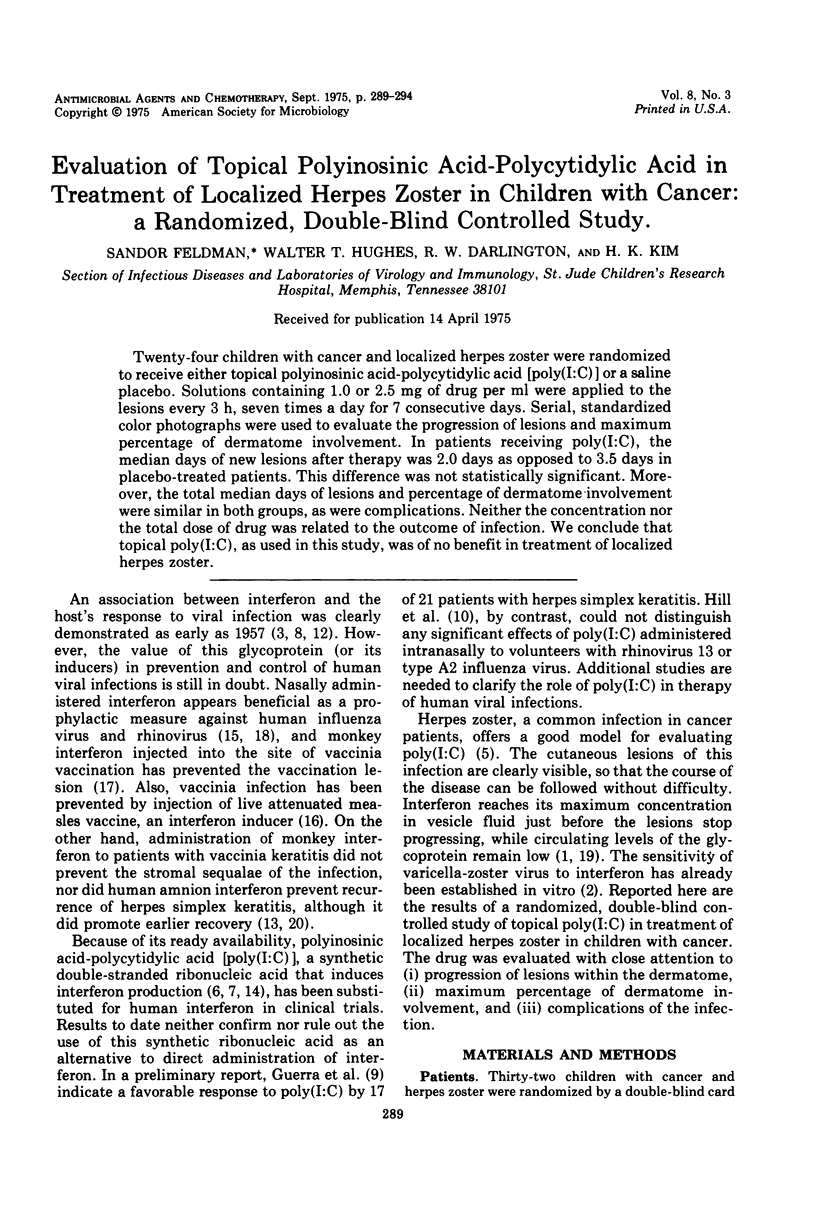
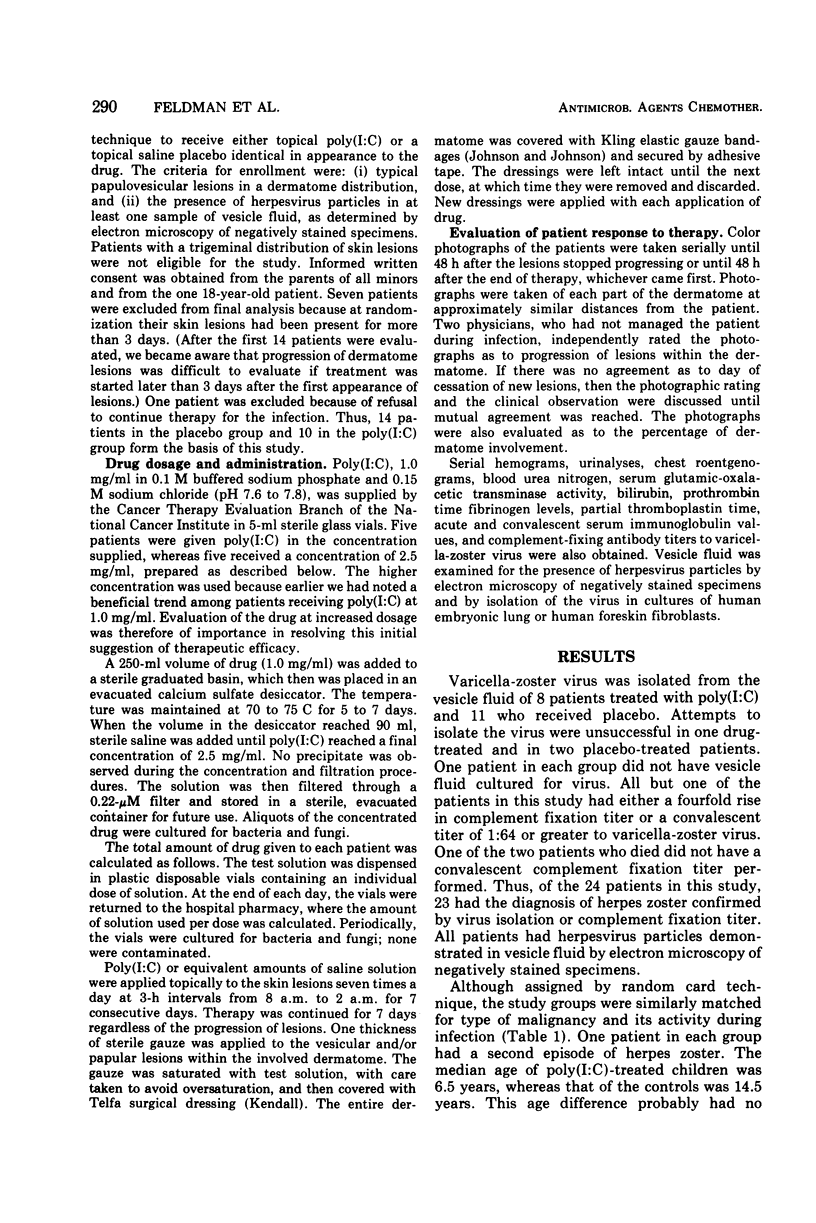
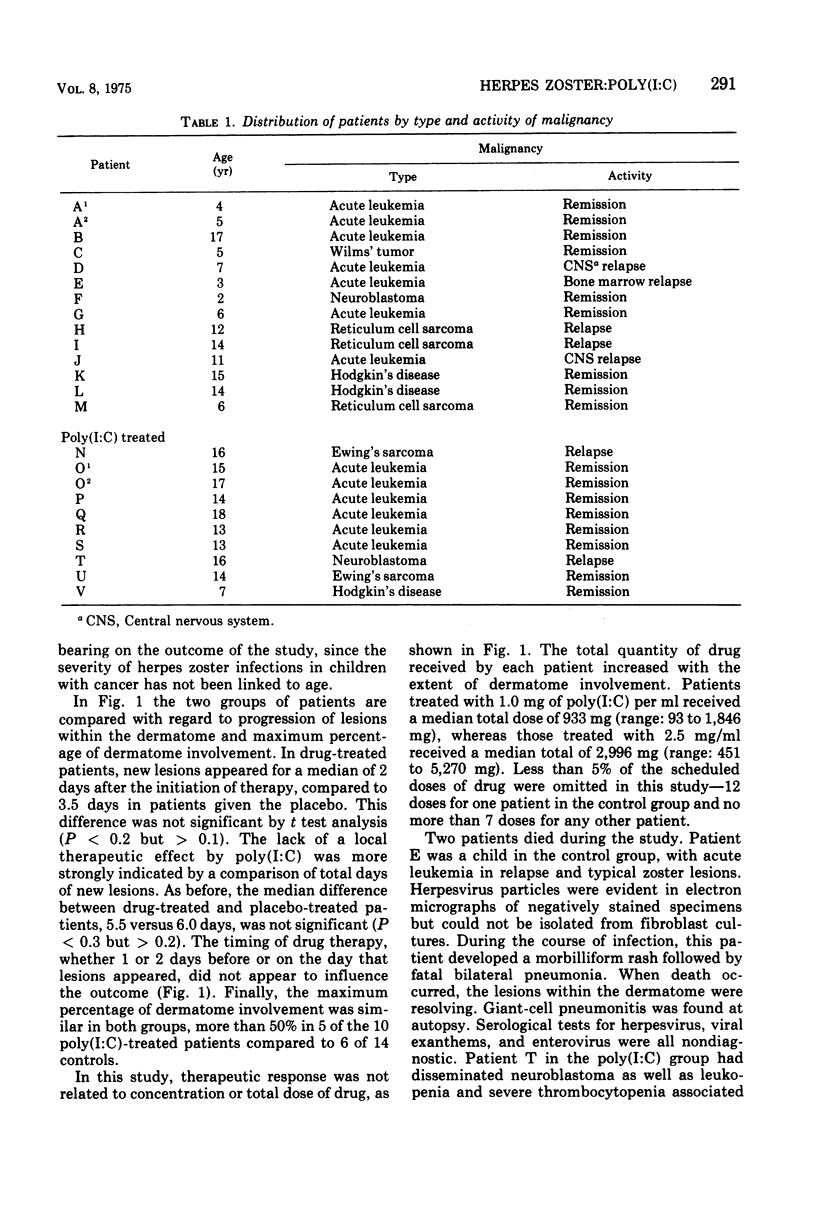
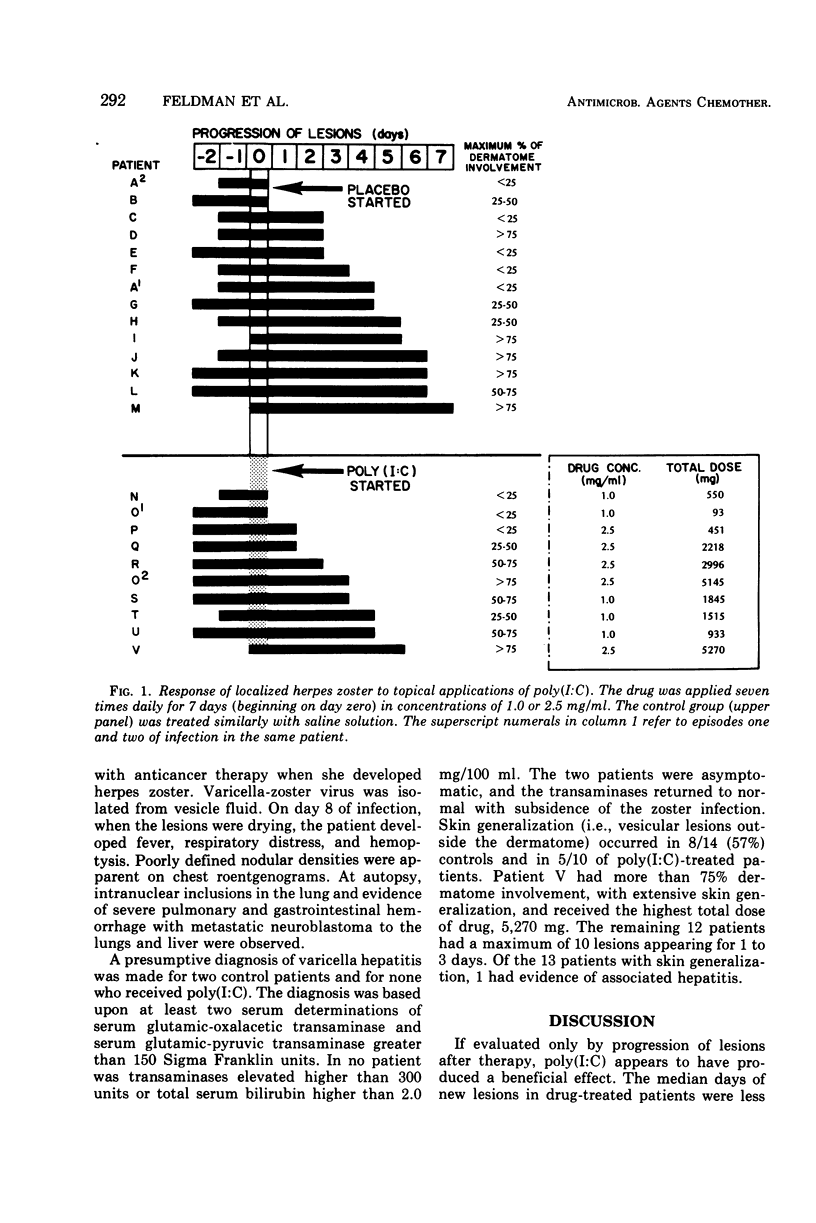

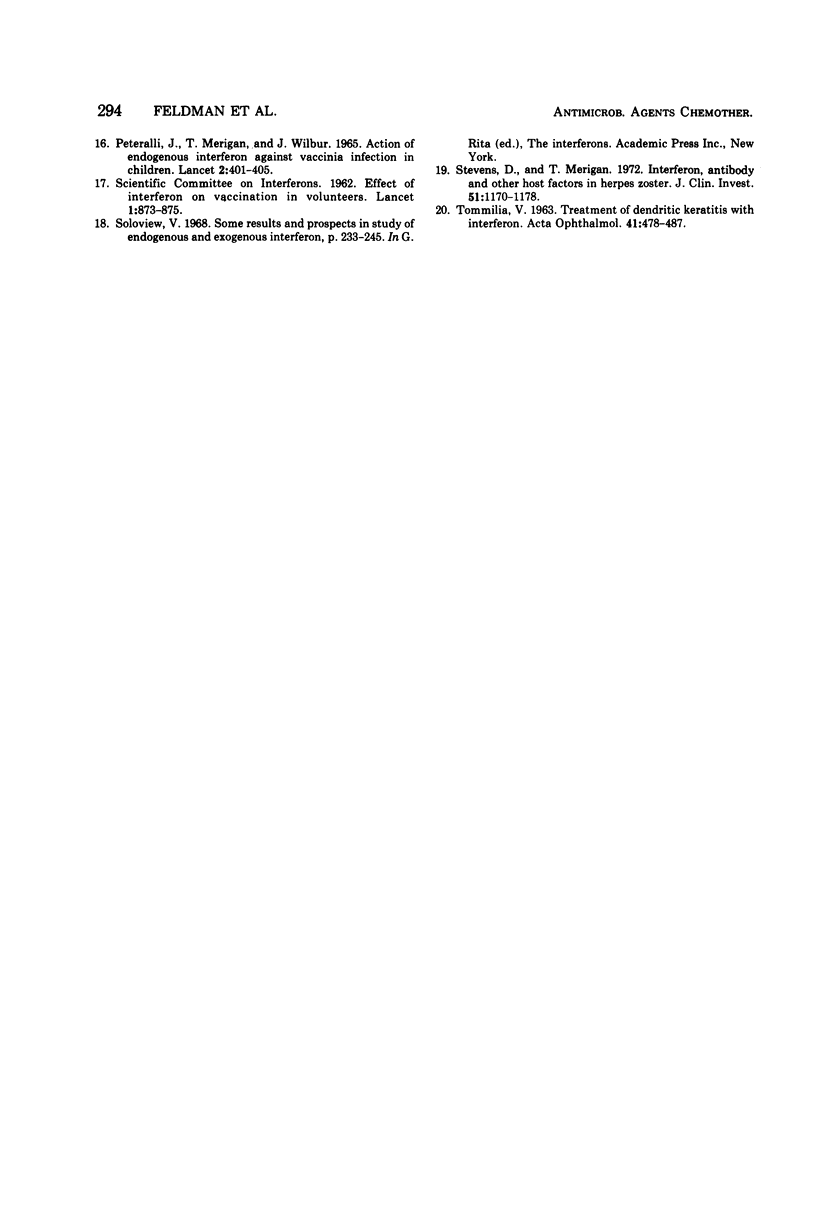
Selected References
These references are in PubMed. This may not be the complete list of references from this article.
- Armstrong R. W., Gurwith M. J., Waddell D., Merigan T. C. Cutaneous interferon production in patients with Hodgkin's disease and other cancers infected with varicella or vaccinia. N Engl J Med. 1970 Nov 26;283(22):1182–1187. doi: 10.1056/NEJM197011262832202. [DOI] [PubMed] [Google Scholar]
- Armstrong R. W., Merigan T. C. Varicella zoster virus: interferon production and comparative interferon sensitivity in human cell cultures. J Gen Virol. 1971 Jul;12(1):53–54. doi: 10.1099/0022-1317-12-1-53. [DOI] [PubMed] [Google Scholar]
- Baron S. The biological significance of the interferon system. Arch Intern Med. 1970 Jul;126(1):84–93. [PubMed] [Google Scholar]
- Esiri M. M., Tomlinson A. H. Herpes Zoster. Demonstration of virus in trigeminal nerve and ganglion by immunofluorescence and electron microscopy. J Neurol Sci. 1972;15(1):35–48. doi: 10.1016/0022-510x(72)90120-7. [DOI] [PubMed] [Google Scholar]
- Feldman S., Hughes W. T., Kim H. Y. Herpes zoster in children with cancer. Am J Dis Child. 1973 Aug;126(2):178–184. doi: 10.1001/archpedi.1973.02110190156009. [DOI] [PubMed] [Google Scholar]
- Field A. K., Tytell A. A., Lampson G. P., Hilleman M. R. Inducers of interferon and host resistance, V. In vitro studies. Proc Natl Acad Sci U S A. 1968 Sep;61(1):340–346. doi: 10.1073/pnas.61.1.340. [DOI] [PMC free article] [PubMed] [Google Scholar]
- Field A. K., Tytell A. A., Lampson G. P., Hilleman M. R. Inducers of interferon and host resistance. II. Multistranded synthetic polynucleotide complexes. Proc Natl Acad Sci U S A. 1967 Sep;58(3):1004–1010. doi: 10.1073/pnas.58.3.1004. [DOI] [PMC free article] [PubMed] [Google Scholar]
- Grossberg S. E. The interferons and their inducers: molecular and therapeutic considerations. 3. N Engl J Med. 1972 Jul 20;287(3):122–128. doi: 10.1056/NEJM197207202870305. [DOI] [PubMed] [Google Scholar]
- HOPE-SIMPSON R. E. THE NATURE OF HERPES ZOSTER: A LONG-TERM STUDY AND A NEW HYPOTHESIS. Proc R Soc Med. 1965 Jan;58:9–20. [PMC free article] [PubMed] [Google Scholar]
- Hill D. A., Baron S., Perkins J. C., Worthington M., Van Kirk J. E., Mills J., Kapikian A. Z., Chanock R. M. Evaluation of an interferon inducer in viral respiratory disease. JAMA. 1972 Feb 28;219(9):1179–1184. [PubMed] [Google Scholar]
- JONES B. R., GALBRAITH J. E., AL-HUSSAINI M. K. Vaccinial keratitis treated with interferon. Lancet. 1962 Apr 28;1(7235):875–879. doi: 10.1016/s0140-6736(62)91908-6. [DOI] [PubMed] [Google Scholar]
- Lampson G. P., Tytell A. A., Field A. K., Nemes M. M., Hilleman M. R. Inducers of interferon and host resistance. I. Double-stranded RNA from extracts of Penicillium funiculosum. Proc Natl Acad Sci U S A. 1967 Aug;58(2):782–789. doi: 10.1073/pnas.58.2.782. [DOI] [PMC free article] [PubMed] [Google Scholar]
- Merigan T. C., Reed S. E., Hall T. S., Tyrrell D. A. Inhibition of respiratory virus infection by locally applied interferon. Lancet. 1973 Mar 17;1(7803):563–567. doi: 10.1016/s0140-6736(73)90714-9. [DOI] [PubMed] [Google Scholar]
- PETRALLI J. K., MERIGAN T. C., WILBUR J. R. ACTION OF ENDOGENOUS INTERFERON AGAINST VACCINIA INFECTION IN CHILDREN. Lancet. 1965 Aug 28;2(7409):401–405. doi: 10.1016/s0140-6736(65)90755-5. [DOI] [PubMed] [Google Scholar]
- Stevens D. A., Merigan T. C. Interferon, antibody, and other host factors in herpes zoster. J Clin Invest. 1972 May;51(5):1170–1178. doi: 10.1172/JCI106910. [DOI] [PMC free article] [PubMed] [Google Scholar]
- TOMMILA V. TREATMENT OF DENDRITIC KERATITIS WITH INTERFERON. Acta Ophthalmol (Copenh) 1963;41:478–482. doi: 10.1111/j.1755-3768.1963.tb03559.x. [DOI] [PubMed] [Google Scholar]


